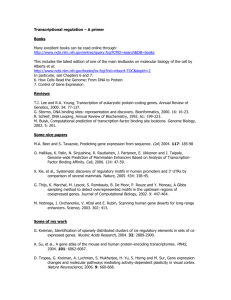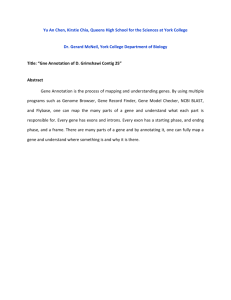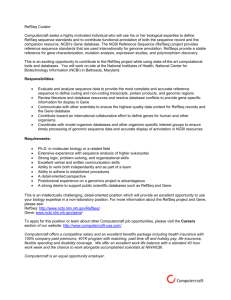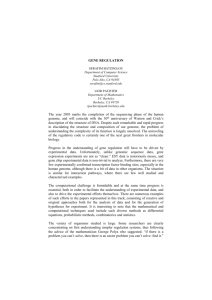MCB5472_Lecture_1_Jan-27-14
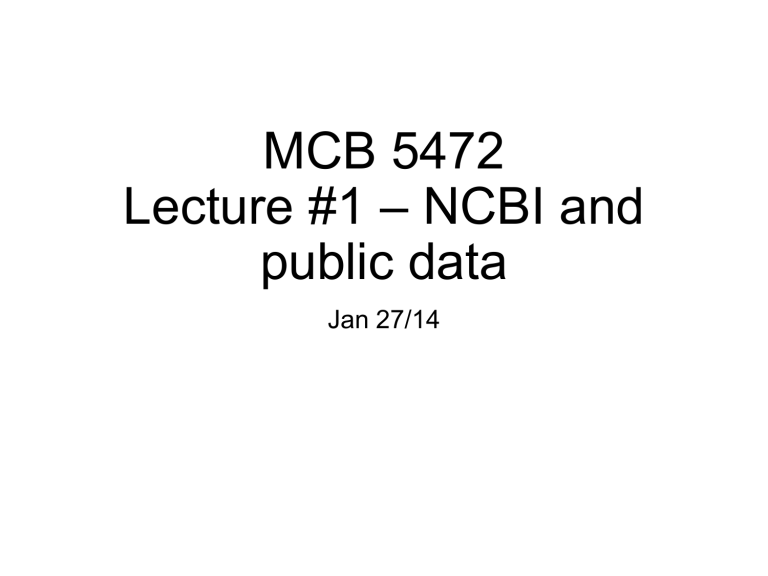
MCB 5472
Lecture #1 – NCBI and public data
Jan 27/14
Pretest question #1
• Define “Evolution by Natural Selection” in one or two sentences
• Variation exists in a population
• Variation is inherited
• Individuals reproduce more than the environment can support, therefore competition occurs
• Differential reproduction is driven by hereditable variation allowing more efficient resource use
Pretest question #2
• Can two sequences that are aligned reasonably well over their whole lengths be
66% homologous?
• Sequences either are or are not homologous.
• Homologous sequences can vary in their similarity
NCBI
• www.ncbi.nlm.nih.gov
• National Center for Biotechnology Information
• Run by the US National Institute of Health
National Library of Medicine
• Since 1988 has been the designated US repository for data relating to biological research
• Also runs its own research program in computational biology
Comprised of 42 databases containing together
>900 million records
NCBI Resource Coordinators Nucl. Acids Res. 2014 42: D7-D17
GenBank
• Central database for nucleotide sequences
• Synced daily with alternative independent databases
• European Nucleotide Archive (ENA)
• DNA Data Bank of Japan (DDBJ)
• Linked to other NCBI resources via Entrez system
GenBank sequence types
• WGS (whole genome sequencing)
• TSA (transcriptome shotgun assembly)
• 12 standard nucleotide types
• Split by taxon + ENV for environmental sequences
• PAT (patent sequences)
• 6 high-throughput types
• EST (expressed sequence tag)
• GSS (genome survey sequence)
• HTC (high-throughput cDNA)
• HTG (high-throughput genomic)
• STS (sequence tagged sites)
NCBI raw nucleotide data
• SRA – Sequence Read Archive: raw nextgeneration sequencing data, typically underpins a GenBank genome assembly
• Trace Archive: raw Sanger sequencing data
Benson et al. Nucl. Acids Res. 2014 42: D32-D37
RefSeq
• RefSeq is a curated collection of annotated sequences
• Typically, raw nucleotide sequences come from
GenBank
• Annotations are typically from NCBI, but sometimes from collaborations with the broader community
• Some quality restrictions for RefSeq annotating
GenBank data
Discuss
1. What makes a database? Why use a database, e.g., vs. a spreadsheet
2. GenBank is a repository, but RefSeq is not.
Why is this significant?
Discuss
3. What data types of genomic data are there?
4. How are these data types related
.gbk files
• NCBI’s standard format of annotating nucleotide sequences
Accession: NCBI’s identifier for this sequence record
Version: NCBI’s identifier for this sequence record version
GI: NCBI’s identifier for this unique document
These features are the only ones that are “stable”, i.e., absolute identifiers
Locus: A name for this stretch of DNA
Length of DNA
Molecule type
GenBank division
Date of last modification
Dblink: other NCBI databases related to this record
Source: the organism from which this sequence was determined
Organism: Taxonomic breakdown for the SOURCE organism, according to
NCBI’s Taxonomy DB
Dblink: other NCBI databases related to this record
Source: the organism from which this sequence was determined
Organism: Taxonomic breakdown for the SOURCE organism, according to
NCBI’s Taxonomy DB
Reference: reference(s) relating to the sequence
Origin: The nucleotide sequence
“//”: always marks the end of the file
“source”: annotations of the entire sequence
Range of the sequence on the molecule
/mol_type: type of molecule sequenced
/organism, /strain,
/sub_strain: taxonomic information
/db_xref: other NCBI database ID
An annotated gene feature
Range of the feature on the “source” sequence
/product: what the gene feature makes, typically descriptive
LOCUS NT_077402 257719 bp DNA linear CON 13-AUG-2013
DEFINITION Homo sapiens chromosome 1 genomic contig, GRCh37.p13 Primary
Assembly.
ACCESSION NT_077402 GPS_000125215 NT_077911
VERSION NT_077402.2 GI:224514618
DBLINK BioProject: PRJNA168
Assembly: GCF_000001405.25
KEYWORDS RefSeq.
SOURCE Homo sapiens (human)
ORGANISM Homo sapiens
A scaffold from the human genome project
Eukaryota; Metazoa; Chordata; Craniata; Vertebrata; Euteleostomi;
Mammalia; Eutheria; Euarchontoglires; Primates; Haplorrhini;
Catarrhini; Hominidae; Homo.
REFERENCE 1 (bases 1 to 257719)
AUTHORS Gregory,S.G., Barlow,K.F., McLay,K.E., Kaul,R., Swarbreck,D.,
Dunham,A., Scott,C.E., Howe,K.L., Woodfine,K., Spencer,C.C.,
Jones,M.C., Gillson,C., Searle,S., Zhou,Y., Kokocinski,F.,
McDonald,L., Evans,R., Phillips,K., Atkinson,A., Cooper,R.,
Jones,C., Hall,R.E., Andrews,T.D., Lloyd,C., Ainscough,R.,
Almeida,J.P., Ambrose,K.D., Anderson,F., Andrew,R.W., Ashwell,R.I.,
Aubin,K., Babbage,A.K., Bagguley,C.L., Bailey,J., Beasley,H.,
Bethel,G., Bird,C.P., Bray-Allen,S., Brown,J.Y., Brown,A.J.,
Buckley,D., Burton,J., Bye,J., Carder,C., Chapman,J.C., Clark,S.Y.,
Clarke,G., Clee,C., Cobley,V., Collier,R.E., Corby,N.,
Coville,G.J., Davies,J., Deadman,R., Dunn,M., Earthrowl,M.,
Ellington,A.G., Errington,H., Frankish,A., Frankland,J., French,L.,
Garner,P., Garnett,J., Gay,L., Ghori,M.R., Gibson,R., Gilby,L.M.,
Gillett,W., Glithero,R.J., Grafham,D.V., Griffiths,C.,
Griffiths-Jones,S., Grocock,R., Hammond,S., Harrison,E.S., Hart,E.,
Haugen,E., Heath,P.D., Holmes,S., Holt,K., Howden,P.J., Hunt,A.R.,
Hunt,S.E., Hunter,G., Isherwood,J., James,R., Johnson,C.,
Johnson,D., Joy,A., Kay,M., Kershaw,J.K., Kibukawa,M.,
Kimberley,A.M., King,A., Knights,A.J., Lad,H., Laird,G., Lawlor,S.,
Leongamornlert,D.A., Lloyd,D.M., Loveland,J., Lovell,J., Lush,M.J.,
Lyne,R., Martin,S., Mashreghi-Mohammadi,M., Matthews,L.,
Matthews,N.S., McLaren,S., Milne,S., Mistry,S., Moore,M.J.,
Nickerson,T., O'Dell,C.N., Oliver,K., Palmeiri,A., Palmer,S.A.,
Parker,A., Patel,D., Pearce,A.V., Peck,A.I., Pelan,S., Phelps,K.,
Phillimore,B.J., Plumb,R., Rajan,J., Raymond,C., Rouse,G.,
Saenphimmachak,C., Sehra,H.K., Sheridan,E., Shownkeen,R., Sims,S.,
Skuce,C.D., Smith,M., Steward,C., Subramanian,S., Sycamore,N.,
Tracey,A., Tromans,A., Van Helmond,Z., Wall,M., Wallis,J.M.,
White,S., Whitehead,S.L., Wilkinson,J.E., Willey,D.L., Williams,H.,
Wilming,L., Wray,P.W., Wu,Z., Coulson,A., Vaudin,M., Sulston,J.E.,
Durbin,R., Hubbard,T., Wooster,R., Dunham,I., Carter,N.P.,
McVean,G., Ross,M.T., Harrow,J., Olson,M.V., Beck,S., Rogers,J.,
Bentley,D.R., Banerjee,R., Bryant,S.P., Burford,D.C., Burrill,W.D.,
Clegg,S.M., Dhami,P., Dovey,O., Faulkner,L.M., Gribble,S.M.,
Langford,C.F., Pandian,R.D., Porter,K.M. and Prigmore,E.
TITLE The DNA sequence and biological annotation of human chromosome 1
JOURNAL Nature 441 (7091), 315-321 (2006)
PUBMED 16710414
The human genome project had a few authors!
REMARK Erratum:[Nature. 2006 Oct 26;443(7114):1013. Banerjee, R [added];
Bryant, SP [added]; Burford, DC [added]; Burrill, WDH [added];
Clegg, SM [added]; Dhami, P [added]; Dovey, O [added]; Faulkner, LM
[added]; Gribble, SM [added]; Langford, CF [added]; Pandian, RD
[added]; Porter, KM [added]; Prigmore, E [added]]
REFERENCE 2 (bases 1 to 257719)
CONSRTM International Human Genome Sequencing Consortium
TITLE Finishing the euchromatic sequence of the human genome
JOURNAL Nature 431 (7011), 931-945 (2004)
PUBMED 15496913
REFERENCE 3 (bases 1 to 257719)
AUTHORS Lander,E.S., Linton,L.M., Birren,B., Nusbaum,C., Zody,M.C.,
Baldwin,J., Devon,K., Dewar,K., Doyle,M., FitzHugh,W., Funke,R.,
Gage,D., Harris,K., Heaford,A., Howland,J., Kann,L., Lehoczky,J.,
LeVine,R., McEwan,P., McKernan,K., Meldrim,J., Mesirov,J.P.,
Miranda,C., Morris,W., Naylor,J., Raymond,C., Rosetti,M.,
Santos,R., Sheridan,A., Sougnez,C., Stange-Thomann,N.,
Stojanovic,N., Subramanian,A., Wyman,D., Rogers,J., Sulston,J.,
Ainscough,R., Beck,S., Bentley,D., Burton,J., Clee,C., Carter,N.,
Coulson,A., Deadman,R., Deloukas,P., Dunham,A., Dunham,I.,
Durbin,R., French,L., Grafham,D., Gregory,S., Hubbard,T.,
Humphray,S., Hunt,A., Jones,M., Lloyd,C., McMurray,A., Matthews,L.,
Mercer,S., Milne,S., Mullikin,J.C., Mungall,A., Plumb,R., Ross,M.,
Shownkeen,R., Sims,S., Waterston,R.H., Wilson,R.K., Hillier,L.W.,
McPherson,J.D., Marra,M.A., Mardis,E.R., Fulton,L.A.,
Chinwalla,A.T., Pepin,K.H., Gish,W.R., Chissoe,S.L., Wendl,M.C.,
Delehaunty,K.D., Miner,T.L., Delehaunty,A., Kramer,J.B., Cook,L.L.,
Fulton,R.S., Johnson,D.L., Minx,P.J., Clifton,S.W., Hawkins,T.,
Branscomb,E., Predki,P., Richardson,P., Wenning,S., Slezak,T.,
Doggett,N., Cheng,J.F., Olsen,A., Lucas,S., Elkin,C.,
Uberbacher,E., Frazier,M., Gibbs,R.A., Muzny,D.M., Scherer,S.E.,
Bouck,J.B., Sodergren,E.J., Worley,K.C., Rives,C.M., Gorrell,J.H.,
Metzker,M.L., Naylor,S.L., Kucherlapati,R.S., Nelson,D.L.,
Weinstock,G.M., Sakaki,Y., Fujiyama,A., Hattori,M., Yada,T.,
Toyoda,A., Itoh,T., Kawagoe,C., Watanabe,H., Totoki,Y., Taylor,T.,
Weissenbach,J., Heilig,R., Saurin,W., Artiguenave,F., Brottier,P.,
Bruls,T., Pelletier,E., Robert,C., Wincker,P., Smith,D.R.,
Doucette-Stamm,L., Rubenfield,M., Weinstock,K., Lee,H.M.,
Dubois,J., Rosenthal,A., Platzer,M., Nyakatura,G., Taudien,S.,
Rump,A., Yang,H., Yu,J., Wang,J., Huang,G., Gu,J., Hood,L.,
Rowen,L., Madan,A., Qin,S., Davis,R.W., Federspiel,N.A.,
Abola,A.P., Proctor,M.J., Myers,R.M., Schmutz,J., Dickson,M.,
Grimwood,J., Cox,D.R., Olson,M.V., Kaul,R., Raymond,C., Shimizu,N.,
Kawasaki,K., Minoshima,S., Evans,G.A., Athanasiou,M., Schultz,R.,
Roe,B.A., Chen,F., Pan,H., Ramser,J., Lehrach,H., Reinhardt,R.,
McCombie,W.R., de la Bastide,M., Dedhia,N., Blocker,H.,
Hornischer,K., Nordsiek,G., Agarwala,R., Aravind,L., Bailey,J.A.,
Bateman,A., Batzoglou,S., Birney,E., Bork,P., Brown,D.G.,
Burge,C.B., Cerutti,L., Chen,H.C., Church,D., Clamp,M.,
Copley,R.R., Doerks,T., Eddy,S.R., Eichler,E.E., Furey,T.S.,
Galagan,J., Gilbert,J.G., Harmon,C., Hayashizaki,Y., Haussler,D.,
Hermjakob,H., Hokamp,K., Jang,W., Johnson,L.S., Jones,T.A.,
Kasif,S., Kaspryzk,A., Kennedy,S., Kent,W.J., Kitts,P.,
Koonin,E.V., Korf,I., Kulp,D., Lancet,D., Lowe,T.M., McLysaght,A.,
Mikkelsen,T., Moran,J.V., Mulder,N., Pollara,V.J., Ponting,C.P.,
Schuler,G., Schultz,J., Slater,G., Smit,A.F., Stupka,E.,
Szustakowski,J., Thierry-Mieg,D., Thierry-Mieg,J., Wagner,L.,
Wallis,J., Wheeler,R., Williams,A., Wolf,Y.I., Wolfe,K.H.,
Yang,S.P., Yeh,R.F., Collins,F., Guyer,M.S., Peterson,J.,
Felsenfeld,A., Wetterstrand,K.A., Patrinos,A., Morgan,M.J., de
Jong,P., Catanese,J.J., Osoegawa,K., Shizuya,H., Choi,S. and
Chen,Y.J.
CONSRTM International Human Genome Sequencing Consortium
TITLE Initial sequencing and analysis of the human genome
JOURNAL Nature 409 (6822), 860-921 (2001)
PUBMED 11237011
REMARK Erratum:[Nature 2001 Aug 2;412(6846):565]
COMMENT REFSEQ INFORMATION: The reference sequence is identical to
GL000001.1.
On or before Jun 10, 2009 this sequence version replaced gi:29794400, gi:29794392.
Assembly Name: GRCh37.p13 Primary Assembly
The DNA sequence is composed of genomic sequence, primarily finished clones that were sequenced as part of the Human Genome
Project. PCR products and WGS shotgun sequence have been added where necessary to fill gaps or correct errors. All such additions are manually curated by GRC staff. For more information see: http://genomereference.org.
Annotation information
##Genome-Annotation-Data-START##
Annotation Provider :: NCBI division-specific methods
Annotation Status :: Full annotation
Annotation Version :: Homo sapiens Annotation Release 105
Annotation Pipeline :: NCBI eukaryotic genome annotation pipeline
Annotation Software Version :: 5.1
Annotation Method :: Best-placed RefSeq; Gnomon
Features Annotated :: Gene; mRNA; CDS; ncRNA
##Genome-Annotation-Data-END##
FEATURES Location/Qualifiers source 1..257719
/organism="Homo sapiens"
/mol_type="genomic DNA"
/db_xref="taxon:9606"
/chromosome="1"
Source field (sequence overview)
gene 1874..4409
/gene="DDX11L1"
/note="DEAD/H (Asp-Glu-Ala-Asp/His) box helicase 11 like
1; Derived by automated computational analysis using gene prediction method: BestRefSeq." misc_RNA
/pseudo
/db_xref="GeneID:100287102"
/db_xref="HGNC:37102" join(1874..2227,2613..2721,3221..4409)
/gene="DDX11L1"
A couple of pseudogenes
/product="DEAD/H (Asp-Glu-Ala-Asp/His) box helicase 11 like 1"
/note="Derived by automated computational analysis using gene prediction method: BestRefSeq."
/pseudo
/transcript_id="NR_046018.2"
/db_xref="GI:389886562"
/db_xref="GeneID:100287102"
/db_xref="HGNC:37102" gene complement(<4362..19370)
/gene="WASH7P"
/gene_synonym="FAM39F; WASH5P"
/note="WAS protein family homolog 7 pseudogene; Derived by automated computational analysis using gene prediction method: BestRefSeq."
/pseudo
Note strand information, misc_RNA
/db_xref="GeneID:653635"
/db_xref="HGNC:38034" complement(join(<4362..4829,4970..5038,5796..5947, splice junctions
6607..6765,6858..7055,7233..7368,7606..7742,7915..8061,
8268..8366,14738..14891,19321..19370))
/gene="WASH7P"
/gene_synonym="FAM39F; WASH5P"
/product="WAS protein family homolog 7 pseudogene"
/note="Derived by automated computational analysis using gene prediction method: BestRefSeq."
/pseudo
/transcript_id="NR_024540.1"
/db_xref="GI:215277009"
/db_xref="GeneID:653635"
STS 4596..4719
/standard_name="G54113"
/db_xref="UniSTS:109350" gene 20366..20503
/gene="MIR1302-2"
Sequence tagged site
/gene_synonym="hsa-mir-1302-2; MIRN1302-2"
/note="microRNA 1302-2; Derived by automated computational analysis using gene prediction method: BestRefSeq."
/db_xref="GeneID:100302278"
/db_xref="HGNC:35294"
/db_xref="miRBase:MI0006363" precursor_RNA 20366..20503
/gene="MIR1302-2"
/gene_synonym="hsa-mir-1302-2; MIRN1302-2"
/product="microRNA 1302-2"
/note="Derived by automated computational analysis using gene prediction method: BestRefSeq."
/transcript_id="NR_036051.1"
/db_xref="GI:301173067" ncRNA
/db_xref="GeneID:100302278"
/db_xref="HGNC:35294"
/db_xref="miRBase:MI0006363"
20438..20458
/gene="MIR1302-2"
/gene_synonym="hsa-mir-1302-2; MIRN1302-2"
/ncRNA_class="miRNA"
/product="hsa-miR-1302"
/note="Derived by automated computational analysis using gene prediction method: BestRefSeq."
/db_xref="miRBase:MIMAT0005890"
/db_xref="GeneID:100302278"
/db_xref="HGNC:35294"
/db_xref="miRBase:MI0006363" ncRNA gene that undergoes processing
gene 59091..60008
/gene="OR4F5"
A protein-coding gene
/note="olfactory receptor, family 4, subfamily F, member
5; Derived by automated computational analysis using gene prediction method: BestRefSeq."
/db_xref="GeneID:79501"
/db_xref="HGNC:14825"
/db_xref="HPRD:14974" mRNA 59091..60008
/gene="OR4F5"
/product="olfactory receptor, family 4, subfamily F, member 5"
/note="Derived by automated computational analysis using gene prediction method: BestRefSeq."
/transcript_id="NM_001005484.1"
/db_xref="GI:53828739"
/db_xref="GeneID:79501"
/db_xref="HGNC:14825"
/db_xref="HPRD:14974"
CDS 59091..60008
/gene="OR4F5"
/note="Derived by automated computational analysis using gene prediction method: BestRefSeq."
/codon_start=1
/product="olfactory receptor 4F5"
/protein_id="NP_001005484.1"
/db_xref="GI:53828740"
/db_xref="CCDS:CCDS30547.1"
/db_xref="GeneID:79501"
/db_xref="HGNC:14825"
/db_xref="HPRD:14974"
Note translation
/translation="MVTEFIFLGLSDSQELQTFLFMLFFVFYGGIVFGNLLIVITVVS
DSHLHSPMYFLLANLSLIDLSLSSVTAPKMITDFFSQRKVISFKGCLVQIFLLHFFGG
SEMVILIAMGFDRYIAICKPLHYTTIMCGNACVGIMAVTWGIGFLHSVSQLAFAVHLL
FCGPNEVDSFYCDLPRVIKLACTDTYRLDIMVIANSGVLTVCSFVLLIISYTIILMTI
QHRPLDKSSKALSTLTAHITVVLLFFGPCVFIYAWPFPIKSLDKFLAVFYSVITPLLN
PIIYTLRNKDMKTAIRQLRKWDAHSSVKF"
gene complement(132447..164392)
/gene="LOC100996442"
/note="Derived by automated computational analysis using gene prediction method: Gnomon."
/db_xref="GeneID:100996442"
A gene with 2 splice varients misc_RNA misc_RNA complement(join(132447..133011,145767..145831,
154263..154791,155884..155942,158100..158165,
163753..164392))
/gene="LOC100996442"
/product="uncharacterized LOC100996442, transcript variant
X2"
/note="Derived by automated computational analysis using gene prediction method: Gnomon. Supporting evidence includes similarity to: 1 EST, and 88% coverage of the annotated genomic feature by RNAseq alignments, including
3 samples with support for all annotated introns"
/transcript_id="XR_246629.1"
/db_xref="GI:530360230"
/db_xref="GeneID:100996442" complement(join(148340..148674,154263..154791,
155884..155942,158100..158165,163753..164392))
/gene="LOC100996442"
/product="uncharacterized LOC100996442, transcript variant
X1"
/note="Derived by automated computational analysis using gene prediction method: Gnomon. Supporting evidence includes similarity to: 4 ESTs, and 86% coverage of the annotated genomic feature by RNAseq alignments, including
4 samples with support for all annotated introns"
/transcript_id="XR_159064.3"
/db_xref="GI:530360229"
/db_xref="GeneID:100996442"
assembly_gap 167418..217417
/estimated_length=50000
/gap_type="within scaffold"
Gap in the sequence
/linkage_evidence="unspecified" gene complement(217770..218778) Another pseudogene
/gene="RPL23AP21"
/gene_synonym="RPL23A_1_1"
/note="ribosomal protein L23a pseudogene 21; Derived by automated computational analysis using gene prediction method: Curated Genomic."
/pseudo
/db_xref="GeneID:728481"
/db_xref="HGNC:35827"
CONTIG join(complement(AP006221.1:36117..36731),AL627309.15:103..166904, gap(50000),AP006222.1:1..40302)
//
• Note that instead of the nucleotide sequences there is instead a reference to several sequences joined together and a gap
• Reflects that the “completed genome” is anything but!
NCBI genomes: Bioprojects
• Allow multiple related data to be linked together
NCBI genomes: Assembly
NCBI genomes
• Frankly, this is a bit of a mess on the website
• Often, records are not in their complete form, i.e., instead consisting of links to subordinate data types, e.g., assembly->nucleotide->protein
• But sometimes these are from GenBank, other times from Refseq
• Genbank, Refseq, Entrez data structures to not overlap in a simple manner
• If you want to download genomic data, this is not the way to do it!
NCBI FTP portal
• ftp://ftp.ncbi.nlm.nih.gov/
• Allows access both from the web and from
Terminal (using the program ftp )
• Includes all of NCBI’s data structures as separate database folders
.fna: chromosome nucleotides
.ffn: genes
.faa: proteins
.gbk: annotated chromosomes
.gbs: scaffolds
.gff: all annotations
.ptt: protein annotations
.rnt: RNA annotations (not mRNA)
gff (Genome Feature Format)
• A compact tabular annotation format, especially common for larger eukaryotic genomes
• Does not include sequences
• An input file type for many genomics programs
(particularly sequence viewers)
Columns:
1: Seq ID
2: Source
3: Type
4: Start
5: End
6: Score
7: Strand
8: Phase
9: Attribues (itself subdivided)
NCBI FTP portal
• Fungi have a similar download structure as bacteria
• Other Eukaryotic genomes unfortunately do not have a standard format in this folder, meaning you have to dig through the Refseq and Genbank folders
• Genome reports have helpful tables linking all this information together: ftp://ftp.ncbi.nlm.nih.gov/genomes/GENOME_REP
ORTS/
• Unfortunately, @$*%# NCBI did not make them tabdelimited so you can’t easily use them in
Excel, or even Perl!
IMG: Integrated Microbial Genomes http://img.jgi.doe.gov/
Ensembl: www.ensembl.org
• Next: Dr. Jill Wegrzyn, Biotechnology Center
Cluster
• Reminder: Assignments due Wed before class
• Note: I will not be very available to answer questions Tues evening
• This Wed: Introduction to Perl part 2



